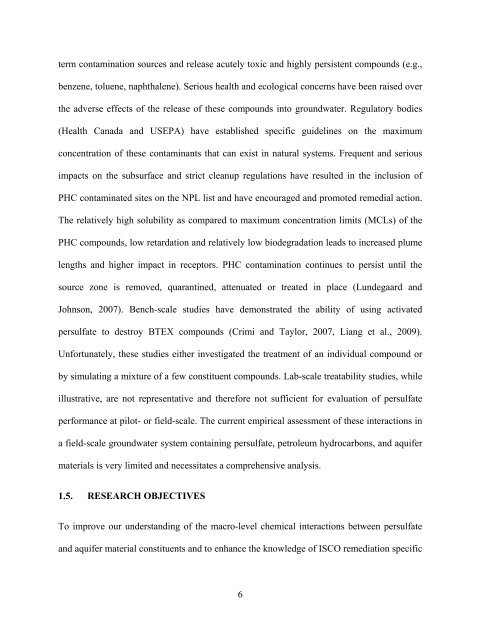Time (days) - UWSpace - University of Waterloo
Time (days) - UWSpace - University of Waterloo
Time (days) - UWSpace - University of Waterloo
You also want an ePaper? Increase the reach of your titles
YUMPU automatically turns print PDFs into web optimized ePapers that Google loves.
term contamination sources and release acutely toxic and highly persistent compounds (e.g.,<br />
benzene, toluene, naphthalene). Serious health and ecological concerns have been raised over<br />
the adverse effects <strong>of</strong> the release <strong>of</strong> these compounds into groundwater. Regulatory bodies<br />
(Health Canada and USEPA) have established specific guidelines on the maximum<br />
concentration <strong>of</strong> these contaminants that can exist in natural systems. Frequent and serious<br />
impacts on the subsurface and strict cleanup regulations have resulted in the inclusion <strong>of</strong><br />
PHC contaminated sites on the NPL list and have encouraged and promoted remedial action.<br />
The relatively high solubility as compared to maximum concentration limits (MCLs) <strong>of</strong> the<br />
PHC compounds, low retardation and relatively low biodegradation leads to increased plume<br />
lengths and higher impact in receptors. PHC contamination continues to persist until the<br />
source zone is removed, quarantined, attenuated or treated in place (Lundegaard and<br />
Johnson, 2007). Bench-scale studies have demonstrated the ability <strong>of</strong> using activated<br />
persulfate to destroy BTEX compounds (Crimi and Taylor, 2007, Liang et al., 2009).<br />
Unfortunately, these studies either investigated the treatment <strong>of</strong> an individual compound or<br />
by simulating a mixture <strong>of</strong> a few constituent compounds. Lab-scale treatability studies, while<br />
illustrative, are not representative and therefore not sufficient for evaluation <strong>of</strong> persulfate<br />
performance at pilot- or field-scale. The current empirical assessment <strong>of</strong> these interactions in<br />
a field-scale groundwater system containing persulfate, petroleum hydrocarbons, and aquifer<br />
materials is very limited and necessitates a comprehensive analysis.<br />
1.5. RESEARCH OBJECTIVES<br />
To improve our understanding <strong>of</strong> the macro-level chemical interactions between persulfate<br />
and aquifer material constituents and to enhance the knowledge <strong>of</strong> ISCO remediation specific<br />
6

















